FENCING HISTORY There is evidence that



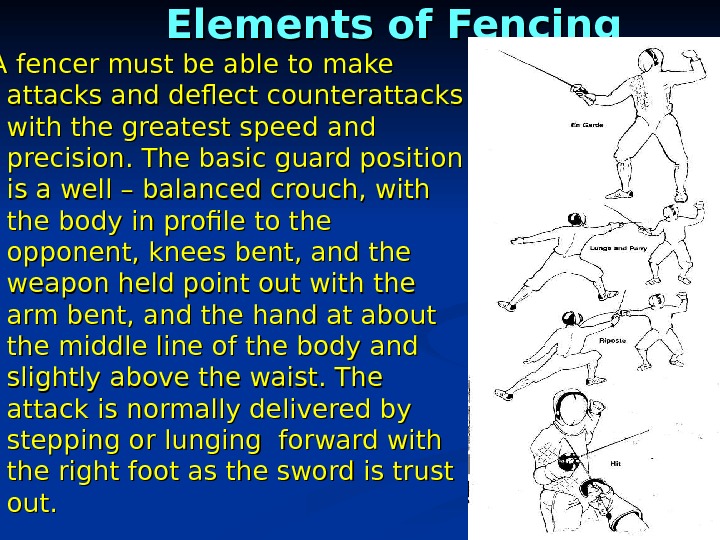

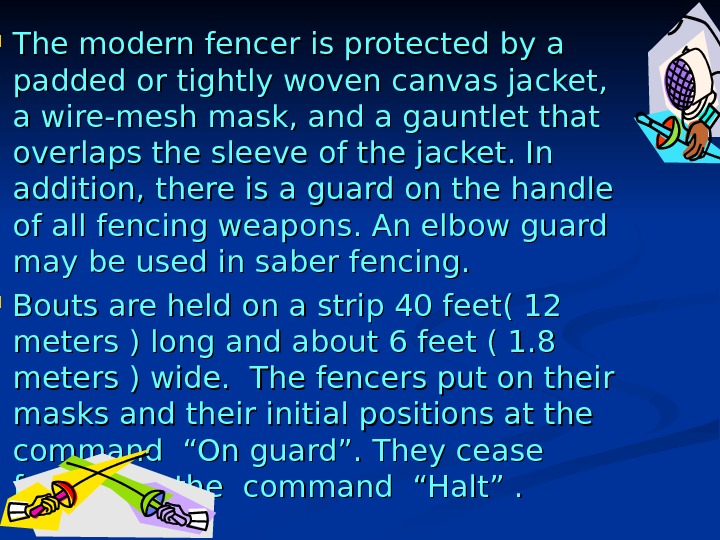
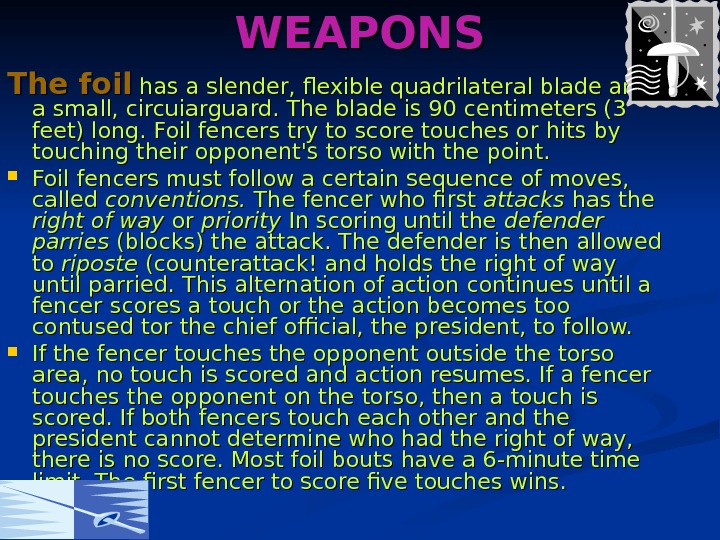

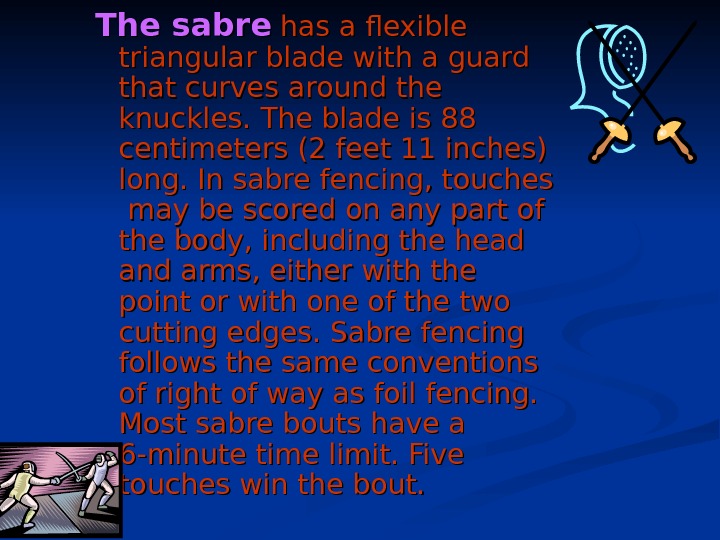
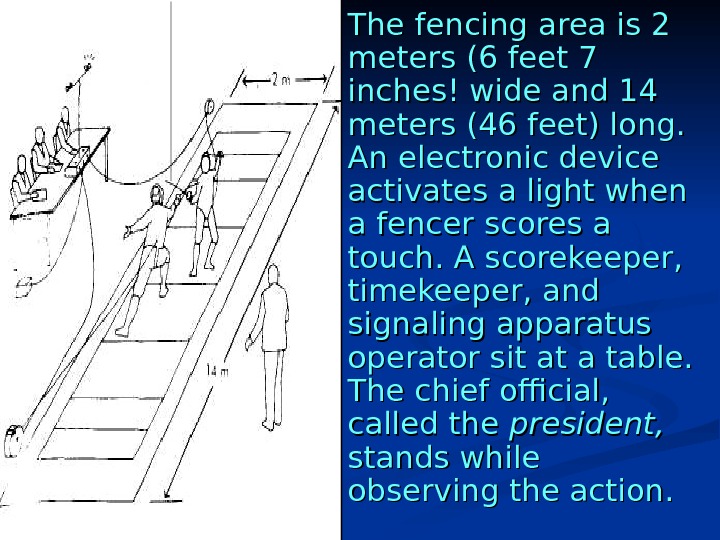

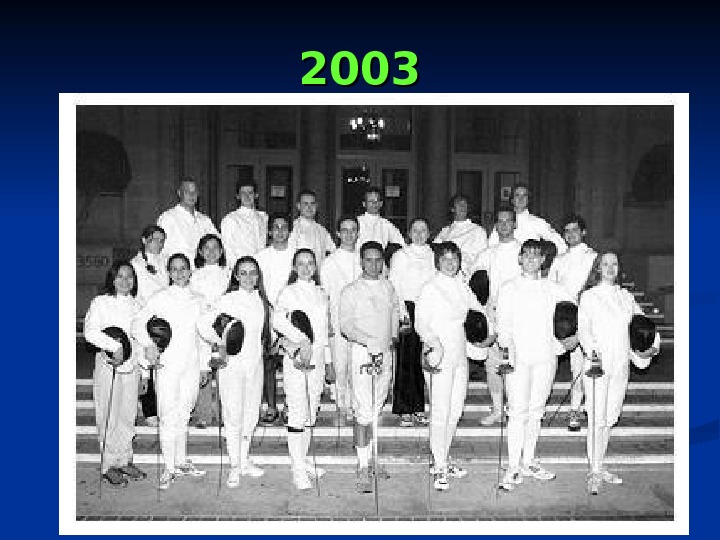
- Размер: 372.5 Кб
- Количество слайдов: 12
Описание презентации FENCING HISTORY There is evidence that по слайдам
 FENCING
FENCING
 HISTORY There is evidence that fencing competitions date back at least 5, 000 years to ancient Egypt and Japan. In Europe, modern swordsmanship dates back to about 1400. Early swords were cumbersome, and sword lighting required more strength than finesse- Fencing in the modern sense dates from the 14 th century, when lightweight swords began to come into use. With the introduction of gunpowder, sword fighting lost importance in warfare, but fencing sur vived as both a sport and a means of settling quarrels by dueling. At Heidelberg and other German universities, affairs of honor were settled for centuries with sabers, and a cut on the cheek was considered a mark of bravery and distinction. An essential part of every aristocratic young man’s education was training with a sword by a fencing master. .
HISTORY There is evidence that fencing competitions date back at least 5, 000 years to ancient Egypt and Japan. In Europe, modern swordsmanship dates back to about 1400. Early swords were cumbersome, and sword lighting required more strength than finesse- Fencing in the modern sense dates from the 14 th century, when lightweight swords began to come into use. With the introduction of gunpowder, sword fighting lost importance in warfare, but fencing sur vived as both a sport and a means of settling quarrels by dueling. At Heidelberg and other German universities, affairs of honor were settled for centuries with sabers, and a cut on the cheek was considered a mark of bravery and distinction. An essential part of every aristocratic young man’s education was training with a sword by a fencing master. .
 During the 16 th century the duel became the com mon method of settling disputes and avenging in sults. Fencing masters secretly taught the art of swordsmanship. Authorities, such as Achille Marozzo, wrote treatises and manuals on fencing tricks, posi tions, and rules. Fencing guilds flourished, especially in Germany. Combat was often two-handed, with the left hand holding a shield, buckler, dagger, or cloak. In the 18 th century, dueling was gradually sup pressed by government decrees, and swordsmanship as a private sport or exhibition began to take its place. The art of fencing was perfected throughout the 19 th century, mostly by French and Italian masters. It remained a private and highly specialized skill, how ever, until the revival of the modern Olympic Games. Fencing has been included as one of the Olympic sports since 1920. The Federation Internationale d’Escrime supervises annual world championship matches. In the United States, fencing matches are held in schools, colleges, and clubs. All U. S. contests are governed by rules of the Amateur Fencers’ League of America, established in 1894.
During the 16 th century the duel became the com mon method of settling disputes and avenging in sults. Fencing masters secretly taught the art of swordsmanship. Authorities, such as Achille Marozzo, wrote treatises and manuals on fencing tricks, posi tions, and rules. Fencing guilds flourished, especially in Germany. Combat was often two-handed, with the left hand holding a shield, buckler, dagger, or cloak. In the 18 th century, dueling was gradually sup pressed by government decrees, and swordsmanship as a private sport or exhibition began to take its place. The art of fencing was perfected throughout the 19 th century, mostly by French and Italian masters. It remained a private and highly specialized skill, how ever, until the revival of the modern Olympic Games. Fencing has been included as one of the Olympic sports since 1920. The Federation Internationale d’Escrime supervises annual world championship matches. In the United States, fencing matches are held in schools, colleges, and clubs. All U. S. contests are governed by rules of the Amateur Fencers’ League of America, established in 1894.
 Elements of Fencing A fencer must be able to make attacks and deflect counterattacks with the greatest speed and precision. The basic guard position is a well – balanced crouch, with the body in profile to the opponent, knees bent, and the weapon held point out with the arm bent, and the hand at about the middle line of the body and slightly above the waist. The attack is normally delivered by stepping or lunging forward with the right foot as the sword is trust out.
Elements of Fencing A fencer must be able to make attacks and deflect counterattacks with the greatest speed and precision. The basic guard position is a well – balanced crouch, with the body in profile to the opponent, knees bent, and the weapon held point out with the arm bent, and the hand at about the middle line of the body and slightly above the waist. The attack is normally delivered by stepping or lunging forward with the right foot as the sword is trust out.
 The basic defense is the parry and riposte. In a parry the guard is is moved to deflect the opponent’s weapon. It is then brought back into position to deliver a riposte, or counterattack. A fencer often tries to draw his opponent into unnecessary parry by a feint, or pretended attack. There are eight basic parry positions, depending on the angle of attack. All successful attacks and defenses depend on expert coordination of hand technique, footwork and body balance.
The basic defense is the parry and riposte. In a parry the guard is is moved to deflect the opponent’s weapon. It is then brought back into position to deliver a riposte, or counterattack. A fencer often tries to draw his opponent into unnecessary parry by a feint, or pretended attack. There are eight basic parry positions, depending on the angle of attack. All successful attacks and defenses depend on expert coordination of hand technique, footwork and body balance.
 The modern fencer is protected by a padded or tightly woven canvas jacket, a wire-mesh mask, and a gauntlet that overlaps the sleeve of the jacket. In addition, there is a guard on the handle of all fencing weapons. An elbow guard may be used in saber fencing. Bouts are held on a strip 40 feet( 12 meters ) long and about 6 feet ( 1. 8 meters ) wide. The fencers put on their masks and their initial positions at the command “On guard”. They cease fencing at the command “Halt”.
The modern fencer is protected by a padded or tightly woven canvas jacket, a wire-mesh mask, and a gauntlet that overlaps the sleeve of the jacket. In addition, there is a guard on the handle of all fencing weapons. An elbow guard may be used in saber fencing. Bouts are held on a strip 40 feet( 12 meters ) long and about 6 feet ( 1. 8 meters ) wide. The fencers put on their masks and their initial positions at the command “On guard”. They cease fencing at the command “Halt”.
 WEAPONS The foil has a slender, flexible quadrilateral blade and a small, circuiarguard. The blade is 90 centimeters (3 feet) long. Foil fencers try to score touches or hits by touching their opponent’s torso with the point. Foil fencers must follow a certain sequence of moves, called conventions. The fencer who first attacks has the right of way or or priority In scoring until the defender par ries (blocks) the attack. The defender is then allowed to to riposte (counterattack! and holds the right of way until parried. This alternation of action continues until a fencer scores a touch or the action becomes too con tused tor the chief official, the president, to follow. If the fencer touches the opponent outside the torso area, no touch is scored and action resumes. If a fencer touches the opponent on the torso, then a touch is scored. If both fencers touch each other and the presi dent cannot determine who had the right of way, there is no score. Most foil bouts have a 6 -minute time limit. The first fencer to score five touches wins.
WEAPONS The foil has a slender, flexible quadrilateral blade and a small, circuiarguard. The blade is 90 centimeters (3 feet) long. Foil fencers try to score touches or hits by touching their opponent’s torso with the point. Foil fencers must follow a certain sequence of moves, called conventions. The fencer who first attacks has the right of way or or priority In scoring until the defender par ries (blocks) the attack. The defender is then allowed to to riposte (counterattack! and holds the right of way until parried. This alternation of action continues until a fencer scores a touch or the action becomes too con tused tor the chief official, the president, to follow. If the fencer touches the opponent outside the torso area, no touch is scored and action resumes. If a fencer touches the opponent on the torso, then a touch is scored. If both fencers touch each other and the presi dent cannot determine who had the right of way, there is no score. Most foil bouts have a 6 -minute time limit. The first fencer to score five touches wins.
 The epee has a rigid triangular blade with a bell-shaped guard. The blade is 90 centimeters long. Epee fencing has no conventions of right of way. Touches on any part of the body count. However, touches must be : scored with the point of the weapon. If both fencers touch each other at the same time, both touches count. Most epee bouts have a 6 -minute time limit Five touches win the bout. Epee fencing for one touch is part of a five-sport competition called the modern pentath lon (see Pentathlon, Modern).
The epee has a rigid triangular blade with a bell-shaped guard. The blade is 90 centimeters long. Epee fencing has no conventions of right of way. Touches on any part of the body count. However, touches must be : scored with the point of the weapon. If both fencers touch each other at the same time, both touches count. Most epee bouts have a 6 -minute time limit Five touches win the bout. Epee fencing for one touch is part of a five-sport competition called the modern pentath lon (see Pentathlon, Modern).
 The sabre has a flexible triangular blade with a guard that curves around the knuckles. The blade is 88 centimeters (2 feet 11 inches) long. In sabre fencing, touches may be scored on any part of the body, including the head and arms, either with the point or with one of the two cutting edges. Sabre fenc ing follows the same conventions of right of way as foil fencing. Most sabre bouts have a 6 -minute time limit. Five touches win the bout.
The sabre has a flexible triangular blade with a guard that curves around the knuckles. The blade is 88 centimeters (2 feet 11 inches) long. In sabre fencing, touches may be scored on any part of the body, including the head and arms, either with the point or with one of the two cutting edges. Sabre fenc ing follows the same conventions of right of way as foil fencing. Most sabre bouts have a 6 -minute time limit. Five touches win the bout.
 The fencing area is 2 meters (6 feet 7 inches! wide and 14 me ters (46 feet) long. An electronic device activates a light when a fencer scores a touch. A scorekeeper, timekeeper, and signaling apparatus operator sit at a table. The chief official, called the president, stands while observing the action.
The fencing area is 2 meters (6 feet 7 inches! wide and 14 me ters (46 feet) long. An electronic device activates a light when a fencer scores a touch. A scorekeeper, timekeeper, and signaling apparatus operator sit at a table. The chief official, called the president, stands while observing the action.
 Fencing organizations The United States Fencing Association (USFA) administers fencing in the United Slates. The USFA is the U. S. member of the International Fencing Federation (FIE). The FIE conducts the world championships and the fencing events of the Olympic Games. The FIE also establishes the official rules of the sport.
Fencing organizations The United States Fencing Association (USFA) administers fencing in the United Slates. The USFA is the U. S. member of the International Fencing Federation (FIE). The FIE conducts the world championships and the fencing events of the Olympic Games. The FIE also establishes the official rules of the sport.

